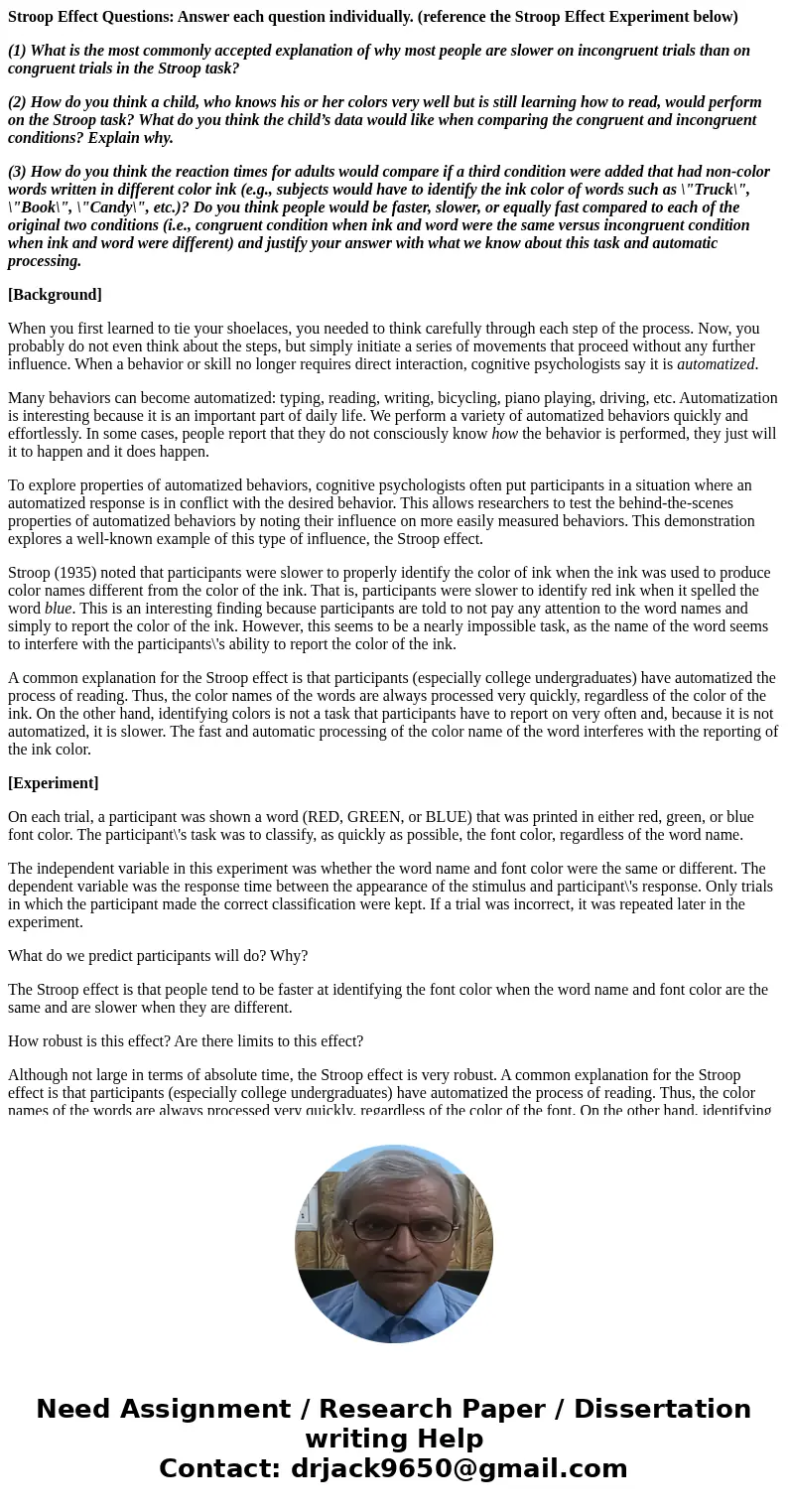Stroop Effect Questions Answer each question individually re
Stroop Effect Questions: Answer each question individually. (reference the Stroop Effect Experiment below)
(1) What is the most commonly accepted explanation of why most people are slower on incongruent trials than on congruent trials in the Stroop task?
(2) How do you think a child, who knows his or her colors very well but is still learning how to read, would perform on the Stroop task? What do you think the child’s data would like when comparing the congruent and incongruent conditions? Explain why.
(3) How do you think the reaction times for adults would compare if a third condition were added that had non-color words written in different color ink (e.g., subjects would have to identify the ink color of words such as \"Truck\", \"Book\", \"Candy\", etc.)? Do you think people would be faster, slower, or equally fast compared to each of the original two conditions (i.e., congruent condition when ink and word were the same versus incongruent condition when ink and word were different) and justify your answer with what we know about this task and automatic processing.
[Background]
When you first learned to tie your shoelaces, you needed to think carefully through each step of the process. Now, you probably do not even think about the steps, but simply initiate a series of movements that proceed without any further influence. When a behavior or skill no longer requires direct interaction, cognitive psychologists say it is automatized.
Many behaviors can become automatized: typing, reading, writing, bicycling, piano playing, driving, etc. Automatization is interesting because it is an important part of daily life. We perform a variety of automatized behaviors quickly and effortlessly. In some cases, people report that they do not consciously know how the behavior is performed, they just will it to happen and it does happen.
To explore properties of automatized behaviors, cognitive psychologists often put participants in a situation where an automatized response is in conflict with the desired behavior. This allows researchers to test the behind-the-scenes properties of automatized behaviors by noting their influence on more easily measured behaviors. This demonstration explores a well-known example of this type of influence, the Stroop effect.
Stroop (1935) noted that participants were slower to properly identify the color of ink when the ink was used to produce color names different from the color of the ink. That is, participants were slower to identify red ink when it spelled the word blue. This is an interesting finding because participants are told to not pay any attention to the word names and simply to report the color of the ink. However, this seems to be a nearly impossible task, as the name of the word seems to interfere with the participants\'s ability to report the color of the ink.
A common explanation for the Stroop effect is that participants (especially college undergraduates) have automatized the process of reading. Thus, the color names of the words are always processed very quickly, regardless of the color of the ink. On the other hand, identifying colors is not a task that participants have to report on very often and, because it is not automatized, it is slower. The fast and automatic processing of the color name of the word interferes with the reporting of the ink color.
[Experiment]
On each trial, a participant was shown a word (RED, GREEN, or BLUE) that was printed in either red, green, or blue font color. The participant\'s task was to classify, as quickly as possible, the font color, regardless of the word name.
The independent variable in this experiment was whether the word name and font color were the same or different. The dependent variable was the response time between the appearance of the stimulus and participant\'s response. Only trials in which the participant made the correct classification were kept. If a trial was incorrect, it was repeated later in the experiment.
What do we predict participants will do? Why?
The Stroop effect is that people tend to be faster at identifying the font color when the word name and font color are the same and are slower when they are different.
How robust is this effect? Are there limits to this effect?
Although not large in terms of absolute time, the Stroop effect is very robust. A common explanation for the Stroop effect is that participants (especially college undergraduates) have automatized the process of reading. Thus, the color names of the words are always processed very quickly, regardless of the color of the font. On the other hand, identifying colors is not a task that participants have to report on very often, and, because it is not automatized, it is slower. The fast, and automatic, processing of the color name of the word interferes with the reporting of the font color.
[Result]
Participant
Global Data
Word and Font Color Same Different 1750 1500 1250 E 1000 750 500 250 Same Different Font Color and Word Mean RT (ms) 1100.000 1607.833Solution
1. The Stroop Effect happens because the names of the colors cause a competing response and therefore slow responding to the target – which is the color of the ink. In the Stroop effect, the task-irrelevant stimuli are very powerful, because reading the words is highly practiced and has become automatic; therefore, it is difficult NOT to read them.
2. Overall, I think that this experiment would be easier for a very young child than for older children or adults. I would imagine that this puzzle would not confuse children because the words would not have any meaning to them.
3. I think the reaction times would be faster, because the names of the colors are the task-irrelevant stimuli, which would happen quicker in the mind due to the automatic response from being highly practiced.


 Homework Sourse
Homework Sourse